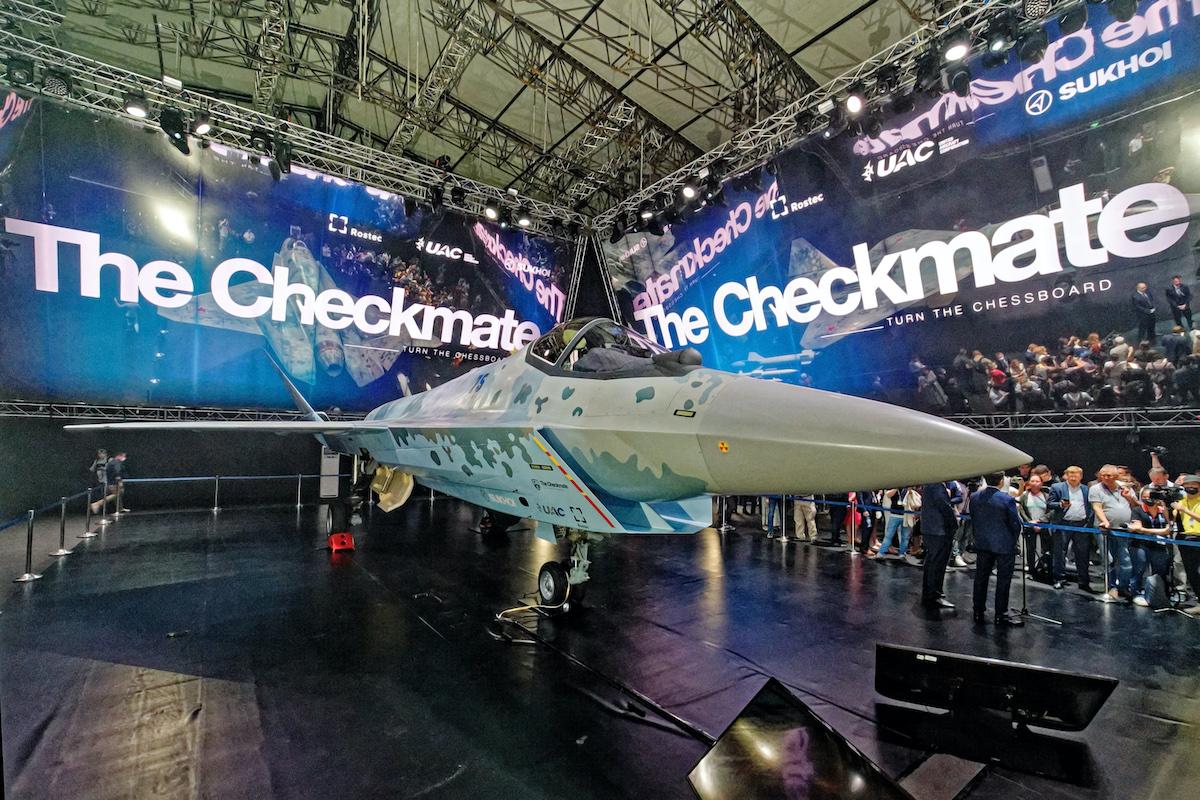Sukhoi’s Checkmate Looks To Carve Out Niche In International Fighter Market

Sukhoi’s single-engine fighter, the sensation of MAKS 2021 in July, makes its international debut in Dubai. But in a way it is a homecoming, because the stimulus that directly pushed Russia to develop the aircraft came from the Emirates.
At IDEX 2017 in Abu Dhabi, Russia and the UAE signed an agreement to cooperate in the development of a next-generation light fighter. The head of Rostec Corporation Sergey Chemezov announced the signing of the appropriate contract later that year. The project, however, did not go any further.
Nevertheless, the development work had been set in motion and Rostec, to which the United Aircraft Corporation (UAC) belongs, decided to continue the project without a foreign partner. In early 2020, Sukhoi started the detailed design work and completed a model aircraft in May 2021. The fighter is promised to make its maiden flight in 2023, and in 2027, full-scale production may start.
The fighter was revealed with the designation LTS (Lightweight Tactical Aircraft) and the English nickname the “Checkmate.” The number “75” was painted on the side—because “the numbers seven and five are lucky for Sukhoi,” says Alexey Bulatov, the deputy chief designer of the project. The 75 is also an inversion of the digits from the designation of the Su-57, which is to be complemented by the new LTS. Since the unveiling, numerous publications have referred to the fighter as the Su-75, a designation which was not explicitly given at the time. However, Russia’s Industry Minister Denis Manturov subsequently agreed that it would be appropriate to designate it the Su-75.
The advertising slogan for the project is “turn the chessboard”—a literal translation of the Russian idiom meaning to change the rules of the game. It is also a somewhat malicious reference to the title of Zbigniew Brzezinski’s book “The Grand Chessboard: American Primacy And Its Geostrategic Imperatives,” which was published in 1997 and carefully read in Russia.
Why is the Checkmate project being carried out with such determination? The first reason is the experience, new technologies and even specific construction elements gained in the course of work on the Su-57. The Checkmate has the same AL-41F1 engine as the Su-57; it also uses the same wing outer panels, vertical fins, and a large part of that type’s systems, avionics and weapons. The Su-57 laid the groundwork, considerably reducing the cost, time and technical risk of the new project.
The second is the readiness of Rostec and UAC to invest their own money, without waiting for an external investor. That decision has been supported by the occasional interest of prospective foreign buyers. The most recent example came from Argentina, which this spring asked Russia for a modern light fighter offer. The cheapest aircraft Russia could suggest was the MiG-35, which is neither light nor cheap. If Russia had a modern single-engine fighter with low operating costs, it would have been a strong candidate there.
Low Price, High Capability
The main advantage of the Su-75 is set to be its low price and high combat potential. UAC CEO Yuri Slyusar said the Checkmate will be offered at a similar price to the Gripen NG; Chemezov set the fighter’s price at $25-30 million. Mikhail Strelets, head of Sukhoi Design Bureau, declared that the Checkmate’s flight-hour cost will be “seven times less” than an F-35’s.
When asked to compare it with the F-35A, Bulatov says the LTS will offer higher speed, longer range and the ability to carry more payloads. It is aimed to reach at least Mach 1.8, over 2,800 km (1,740 mi.) range on one tank of fuel and has a 16.5-km (53,800-ft.) altitude ceiling. Unlike the F-35, the Checkmate “is a full-fledged supersonic fighter,” says Bulatov, echoing Russian opinions that are highly critical of the F-35’s flight characteristics.
Chemezov said in July that there was no launch customer for the Checkmate, but “we see a demand for such an airplane.” According to Slyusar, UAC expects to sell 300 fighters over 15 years, and this is “not wishful thinking, but a careful calculation of market demand.”
The Su-75 may be offered to the Indian contest for 114 Multi-Role Fighter Aircraft; however, the competition there is extremely strong. Other potential large customers—Algeria, Egypt, Vietnam, and former USSR states Armenia, Belarus and Kazakhstan—have recently bought MiG-29Ms or Su-30s and will not need new aircraft soon. Iran could be a significant buyer, once sanctions are lifted. Smaller customers could be current MiG-29 operators, such as Bangladesh, Cuba, Myanmar, North Korea, Peru, Serbia, Sudan and Syria. There may also be exotic clients, outside the pool of traditional Russian aircraft buyers, such as Argentina or UAE, from where the story started. The Russian Aerospace Forces would buy Su-75s if the Kremlin believes it would support exports of the fighter. Notably, the Checkmate trailer features “pilots” from Argentina, India, the UAE and Vietnam.
While the Su-75 will not overturn the chessboard, it looks certain to find its niche in the international fighter market.